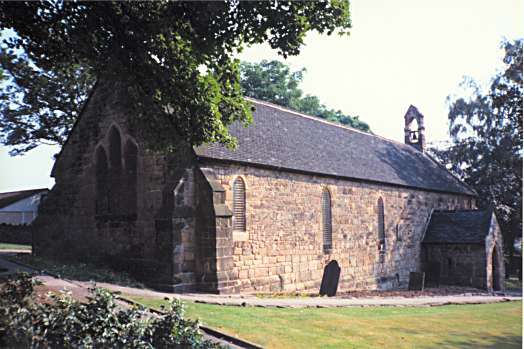
Belper, a small town by the River Derwent in Derbyshire, has grown from a tiny Anglo-Saxon settlement to a thriving market town in the 1,300 years of its existence. However, it remained a small village until the arrival of the textile mills which provided the impetus for its development from the 18th century onwards.
The early settlement was notable for its large deer-park, a royal hunting ground known as Lady Park in the 13th century. The de Ferrers family came to be Lords of the Manor at that time, and they owned a grand Manor House in the Royal Park, used as a hunting lodge. It was demolished in the 1600's.
The de Ferrers also built St. John's Chapel in 1250 for the use of the foresters of the Royal Hunting Preserve. (This Chapel survives and can be seen in the photo below.)

The major part of the settlement of Belper lay on the western side of the Derwent, on grassy slopes overlooking the river. In the 16th century, Belper - a Chapelry of the Parish of Duffield - consisted of a small market square, a few homesteads, farms and cottages as well as the Manor House and Chapel.
Apart from farming, the budding Belper industries were the exploitation of the coal and iron ore deposits of the area, the iron being used by the Belper nailmakers who comprised the major workforce of the town up to the end of the 16th century. The population of Belper in 1741 was listed as 532 persons, living in 113 houses. (From E. G. Power, "A Textile Community in the Industrial Revolution", 1963.)
Nail Making
Although possibly dating back to Roman times, nailmaking was definitely established in Belper by the de Ferrers, the inhabitants using local iron ore to make nails for the huntsmen's horses and for building works. The "De Ferrers" were iron-workers for William the Conqueror, as their name suggests, and introduced forges to Britain. The Duchy of Lancaster records (1314 - 1315) list two forges for Belper.
The Belper nailers were a strong and independent bunch, who could be disruptive but were just as often men of good character and "pillars of society". Some of the nailers who owned land in Hutfall Field, where our house is located, became notable figures in Belper and were members of the local churches. They worked to what we now called "flexitime" (taking every Monday off!) and were also "home-workers" with a workshop in or attached to their houses. Often their trade and equipment was passed down from father to son.

Nailer's Workshop in Joseph Street
In the will of George Watson, a nailer who lived just down the lane from this house, he mentions his cast-iron anvil which he wills to his eldest son.
Belper nails were considered to be superior to any in the country and over time achieved quite a reputation, even being exported to America.
This nailmaking industry lasted throughout Belper's history right up to, and beyond, the establishment of the cotton mills. The Strutts in fact encouraged the male members of the nail-making profession by building nail-shops onto their houses, for they needed only the women and children to work in their cotton mills.
In 1846 there were 400 workers employed making common nails and 250 making horse nails; two million nails being produced weekly. However, the industry suffered a swift decline after the appearance of machine-made nails, and by 1900 almost all local nailmakers were out of business.
The Ward family of Belper, later of the hosiery firm of Ward, Brettle and Ward, also provided much employment for Belper inhabitants, by renting out knitting machines and supplying yarn to workers who laboured in specially constructed terraced houses with a second or third storey giving maximum light for the work.
Many of these cottages can still be seen in Belper, as well as the humbler nailers' cottages. The home worker's scheme died out in the 1870's, but the Brettle's factory grew and prospered, becoming the largest employer in Belper.
The firm sold out to Courtaulds in 1964, and by 1987 all the buildings were empty and disused; the main Brettle's building is now being used as a factory shop for designer wear.
Strutt's Mills
However, it was the mills of Jedediah Strutt, on land bought for him by William Slater, that altered Belper for ever, attracting works and industry to the town. (See the MILL page, for photos and history.)
The first mill, the South Mill, was built in 1776, the North Mill in 1786, and the West Mill, East Mill, Round Mill, and the last brick Mill (1912) followed in continuous expansion. (Almost all the Mills were demolished in the 1950's, and the remaining "new" North Mill is leased out as offices.)
In order to provide for his growing workforce, Jedediah Strutt arranged for the building of workers' cottages and later managers' houses were erected on land bought up around the Mills, including the plot of land on which our house now stands.
The first houses were built in a block called "Short Rows" and consisted of "Hedge Row" now on Mill Street, Dark Row and what is now called Short Row around 1780 together with Field Row.
Also built by the Strutt family in mid-late 1700's were Long Row in 1792-93, and "The Clusters". 
HIGHER-QUALITY WORKER'S HOUSES IN BACK-TO-BACK STYLE IN "THE CLUSTERS"
It appears that successive plots of land were bought from local owners to accommodate these houses. As well as this, Jedediah, a Unitarian, built at his own expense an imposing Unitarian Chapel in 1788.






